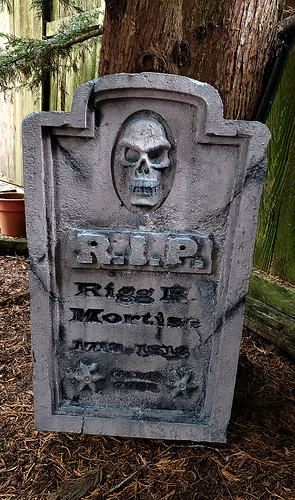This Halloween tombstone was assembled from six CNC carved pieces: face, frame, skull, RIP plaque, and two flowers. It was carved out of foam insulation board purchased at Home Depot. I found a skull on Thingiverse, extracted just the face, and relief carved it for the skull decroation. Going from raw foam to finished piece, I used a number of techniques that I’ve never done before. And while I will do a number of things differently next time, I’m happy with how this first attempt turned out. My biggest issue is that the v-carved text is difficult to read. Next time I’ll pocket out the text like it is done on most tombstones.
That looks awesome! Another idea to add to the list. Was the texture cut or sprayed on after you glued it up?
If you mean “cut” by the CNC, then no, the foam with smooth coming off the CNC. The major breaks and crumbles were cut with a large knife. Next time I’ll be more aggressive with this type of cutting since later steps tended to heal minor cuts and mute major ones. Then I sprayed/misted water over the face and stroked the face with a propane torch. A heat gun worked also, but I liked the torch better. This provided the major texture. It was then coated in “monster mud” which is a mixture of joint compound and exterior latex paint. I added sand to the monster mud which provides the minor/sand texture. Finally the monster mud is stiff and shows brush strokes, so I stippled the whole face with a paint brush. I’ve used monster mud before, but all the texturing techniques were new to me.
I made bricks for a fireplace using structural foam. What I found is that if you use spray-paint pimer on the foam, the propellants will partially melt the foam. If you do really light passes, then it does an awesome job of giving the foam a very stone-like texture. Once you get enough coats of primer on it, then it will no longer eat the foam. You can then paint it whatever color you want.
Definitely practice on some scrap as it took me a few tries to figure out how thick I could put the paint on to get the texture I wanted.
That’s cool. I’ve unintentionally melted foam using both spray adhesive and spray paint, but I’ve never though to use it as a texturing solution. In theory, I could I could hand paint on parts of the foam to protect those areas and then use the spray paint to melt around the hand-painted areas. BTW I’ve recently found out that Permatex Automotive Headliner Adhesive will glue foam without melting it.
